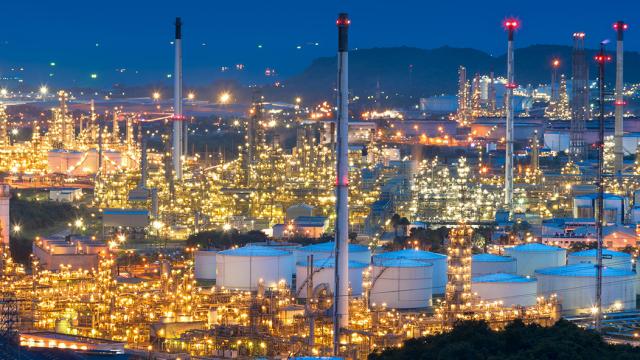
It’s no surprise that opportunities for midstream operators continue to develop as more crude oil, natural gas and NGL are produced. What is coming as a bit of a surprise are the areas in which these opportunities are coming in, which is outside of the midstream space.
Not only are midstream operators continuing to build pipelines, fractionators and gas processing plants, they’ve also taken to building export terminals and becoming more involved with alternate modes of transporting crude and NGL, such as rail and truck. However, some midstream operators are further expanding into the downstream by developing petrochemical projects.
These downstream moves are being fueled by increased demand for petrochemical products. According to a recent report from the International Energy Agency (IEA), petrochemicals—and not transportation—are expected to account for about one-third of global crude oil demand by 2030 and half of global demand by 2050.
The IEA noted that demand for plastics has nearly doubled since the start of this century and is outpacing demand for other bulk materials like steel, aluminum, and cement. “Advanced economies currently use up to 20 times more plastic and up to 10 times more fertilizer than developing economies on a per capita basis, underscoring the huge potential for global growth,” the agency said in a release.
While the Middle East has the lowest costs for making many petrochemicals, North American companies are becoming a major player in this sector. American and Canadian companies are benefitting from a combination of cheap NGL, specifically ethane and propane, and the large volume of ethane-based petrochemical production capacity.
“Cheap and abundant natural gas and NGLs represent cost-advantaged feedstock for North American petrochemical projects,” Stacey Morris, director of research at Alerian, told Hart Energy.
This potential is leading several midstream companies, notably Enterprise Products Partners LP, Inter Pipeline Ltd., and Pembina Pipeline Corp., to develop downstream-related projects. These moves are coming at a quicker pace, but they don’t necessarily represent an entirely new market for the midstream.
“Expectations for robust demand growth have sparked interest in petrochemicals among select midstream companies, but petchem projects are not new in midstream,” Michael Laitkep, energy research analyst at Alerian, said in a research note, “Petrochemicals Provide Midstream Opportunities Downstream.”
He noted that Enterprise formed a joint venture in August 1999 with Exxon Chemical Co. to build a propylene concentration unit to convert refinery-grade propylene into chemical-grade propylene.
“Given Enterprise’s history, it’s unsurprising that they have been the leader in midstream when it comes to petchem projects,” Laitkep said. Indeed, Enterprise officials recently announced that nearly a quarter of the company’s $6 billion project expenditure backlog is dedicated to petrochemical projects.
This past fall Enterprise’s 750,000 metric ton per year propane dehydrogenation (PDH) plant along the Gulf Coast was brought to full capacity. This project was delayed by nearly two years due to cost overruns, as well as the impact of Hurricane Harvey. Demand for propylene is so high that Enterprise officials said they may build a second and third PDH plant.
Additionally, the company is building a 425,000 metric ton per year isobutane dehydrogenation unit in Mont Belvieu, Texas, that is expected to come online by year-end 2019. This facility will create feedstock for other Enterprise petrochemical plants.
As Enterprise looks to build its petchem projects along the Gulf Coast, other midstream companies are active in the downstream much further north in Alberta, Canada. Inter Pipeline is building the first integrated PDH and polypropylene facility in Canada. The C$3.5 billion Heartland Petrochemical Complex is being constructed in Alberta and is scheduled to come online in 2021. This plant will help integrate the company’s petrochemicals and NGL operations.
While the Heartland Petrochemical Complex is the first such facility in Canada, a second plant is set to come online shortly afterward as Pembina Pipeline recently announced plans for a C$4.5 billion 550,000-metric-tonne-per-year integrated PDH plant. This facility, which will also be located in Alberta, is a joint venture with Kuwait’s Petrochemical Industries Co. It is expected this plant will be fully operational by the middle of 2023.
Despite these moves, Alerian cautions that it’s not likely there will be a widespread transition into the downstream for midstream operators. “Admittedly, there are only a few midstream companies expanding into petchem today. The move won't make sense for all midstream companies. For example, such a move would be more of a leap for midstream companies focused on crude and refined products pipelines than midstream companies with existing NGL fractionation capacity. Petchem undoubtedly represents a growth opportunity for midstream, but there are currently plenty of growth opportunities for more traditional assets,” Morris said.
Although some projects may focus on just domestic or export use, it’s likely that most of these petrochemical projects will be a combination of both, she said. Morris added that it would be unlikely for midstream operators expanding into petrochemicals to be spun off as a separate company since two of the biggest benefits of this expansion is diversification and exposure to different demand drivers.
“Similar to other MLP assets, petchem plants can generate fee-based cash flows under long-term contracts with typical MLP contract features such as take-or-pay agreements. In this way, petrochemical projects retain the stable and predictable cash flow characteristics of the MLP model. Petchem represents an opportunity to diversify traditional midstream revenue while retaining stable cash flows,” Morris said.
Recommended Reading
Defeating the ‘Four Horsemen’ of Flow Assurance
2024-04-18 - Service companies combine processes and techniques to mitigate the impact of paraffin, asphaltenes, hydrates and scale on production—and keep the cash flowing.
Tech Trends: AI Increasing Data Center Demand for Energy
2024-04-16 - In this month’s Tech Trends, new technologies equipped with artificial intelligence take the forefront, as they assist with safety and seismic fault detection. Also, independent contractor Stena Drilling begins upgrades for their Evolution drillship.
AVEVA: Immersive Tech, Augmented Reality and What’s New in the Cloud
2024-04-15 - Rob McGreevy, AVEVA’s chief product officer, talks about technology advancements that give employees on the job training without any of the risks.
Lift-off: How AI is Boosting Field and Employee Productivity
2024-04-12 - From data extraction to well optimization, the oil and gas industry embraces AI.
AI Poised to Break Out of its Oilfield Niche
2024-04-11 - At the AI in Oil & Gas Conference in Houston, experts talked up the benefits artificial intelligence can provide to the downstream, midstream and upstream sectors, while assuring the audience humans will still run the show.






